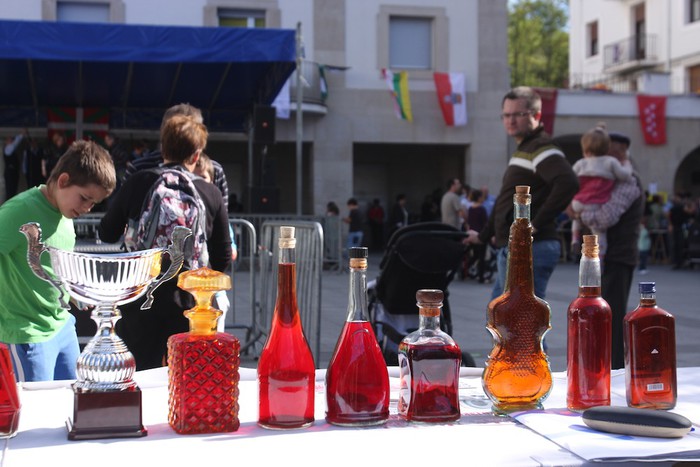Patxaran casero.jpg on:
[Wikipedia]
[Google]
[Amazon]
 Patxaran () ( es, Pacharán) is a sloe-flavoured
Patxaran () ( es, Pacharán) is a sloe-flavoured
 The word ''patxaran'' is the
The word ''patxaran'' is the
 Common Pacharán brands include ''Zoco'', ''Etxeko'', ''Basarana'', ''Berezko'', ''Usua'', ''La Navarra'', ''Las Endrinas'' and ''Baines''.
Seven million litres a year are commercially produced.
Common Pacharán brands include ''Zoco'', ''Etxeko'', ''Basarana'', ''Berezko'', ''Usua'', ''La Navarra'', ''Las Endrinas'' and ''Baines''.
Seven million litres a year are commercially produced.
Website of official Patxaran regulator
{{Authority control Basque cuisine Navarre culture Spanish liqueurs Berry liqueurs Anise liqueurs and spirits
 Patxaran () ( es, Pacharán) is a sloe-flavoured
Patxaran () ( es, Pacharán) is a sloe-flavoured liqueur
A liqueur (; ; ) is an alcoholic drink composed of spirits (often rectified spirit) and additional flavorings such as sugar, fruits, herbs, and spices. Often served with or after dessert, they are typically heavily sweetened and un-aged beyond ...
commonly drunk in Navarre
Navarre (; es, Navarra ; eu, Nafarroa ), officially the Chartered Community of Navarre ( es, Comunidad Foral de Navarra, links=no ; eu, Nafarroako Foru Komunitatea, links=no ), is a foral autonomous community and province in northern Spain, ...
, and other areas of Spain. It is usually served as a digestif either chilled or on ice.
Etymology
 The word ''patxaran'' is the
The word ''patxaran'' is the Upper Navarrese
Upper Navarrese (sometimes called High Navarrese) is a dialect of the Basque language spoken in the Navarre ( eu, Nafarroa or ''Nafarroa Garaia'') community of Spain, as established by linguist Louis Lucien Bonaparte in his famous 1869 map. He ...
form of ''basaran'', from Basque ''basa'' 'wild' and ''aran'' 'sloe'. It also occurs in the various Basque dialects as ''baxaran'', ''basarhan'', ''baixaran'' and various other forms.
Process
Patxaran is made by soaking sloe fruits, collected from the blackthorn shrub, along with a few coffee beans and acinnamon
Cinnamon is a spice obtained from the inner bark of several tree species from the genus ''Cinnamomum''. Cinnamon is used mainly as an aromatic condiment and flavouring additive in a wide variety of cuisines, sweet and savoury dishes, breakfa ...
stick in anisette, for one to eight months. The process produces a light sweet reddish-brown liquid around 25-30% in alcohol content by volume. In addition to dictating the amount of sloes to be used, the regulating body for Pacharán Navarro insists that no colourings or flavourings be added and that the maceration last between one and eight months.
History
Known to have existed in Navarre as early as the Middle Ages, Patxaran was initially a home-made liqueur of rural Navarre and became popular during the late 19th century. It was commercialised in the 1950s and then became very popular outside Navarre. One theory for this rise holds that young Navarrese took bottles with them while on the National service, thereby popularising Patxaran throughout Spain. It now holds a PGI (protected geographical indication) status that protects the spirit's identity, including traditions and processes to make it, and also indicates that it can only be made and bottled in specific areas. Society of Wine Educators 2020 Certified Specialist of Spirits Study Guide TextCommercial brands and production
 Common Pacharán brands include ''Zoco'', ''Etxeko'', ''Basarana'', ''Berezko'', ''Usua'', ''La Navarra'', ''Las Endrinas'' and ''Baines''.
Seven million litres a year are commercially produced.
Common Pacharán brands include ''Zoco'', ''Etxeko'', ''Basarana'', ''Berezko'', ''Usua'', ''La Navarra'', ''Las Endrinas'' and ''Baines''.
Seven million litres a year are commercially produced.
See also
* Sloe ginReferences
External links
Website of official Patxaran regulator
{{Authority control Basque cuisine Navarre culture Spanish liqueurs Berry liqueurs Anise liqueurs and spirits